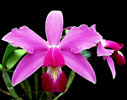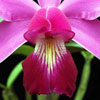|
|
|
|
|
| |
Flasks of
Cattleya violacea 'MC2319' × self |
|
| |
|
|
| |
| Number: |
TN4005 |
| Name: |
Cattleya violacea 'MC2319' × self
|
| Type: |
self (What's that?) |
|
Seed Donor: |
Dale Borders
|
|
Click to Enlarge

Pod Parent Flowers |
Click to Enlarge

Pod Parent Closeup of Labellum |
|
|
|
| |
Culture Notes from Donor: Parent plant: Temperature range I (60-83°F)
For additional origin/habitat information supplied courtesy of
Charles and Margaret Baker, see further below, near the bottom of this page.
|
Temperatures we attempt to use in the lab & greenhouse:
| For Species: |
|
Spring, Summer, Autumn, Winter: days average 85°F, nights 71°F; best fit is Warm 90-70°F
(Source:
Baker's Web OSC) |
| For Genus: |
|
Spring, Summer, Autumn, Winter: days average 83°F, nights 60°F; best fit is Intermediate 83-60°F
(
) |
|
About the name...
| Etymology of |
Cattleya |
|
Named in honor of William Cattley, English horticulturist in the 19th century.
(Source:
Pridgeon 1992) |
| Etymology of |
violacea |
|
From Latin "violaceus" purple.
(Source:
Mayr & Schmucker 1998) |
| Pronunciation of |
Cattleya |
|
KAT-lee-ya
(Sources:
Pridgeon 1992, Hawkes 1978) |
| Pronunciation of |
violacea |
|
vy-oh-LAH-see-ah
(Source:
Hawkes 1978) |
|
If you would like to direct someone to this web page, please copy and paste this URL into your email:
http://troymeyers.com/d?014005
| Flask Information |
| Availability: |
Capsules failed. We were not able to make any flasks. |
| You should: |
Consider placing a "Notify Retries" Request, and if an identical pollination (the same parents) is done again, we'll let you know. |
|
You might also want to:
|
View items of the same species.
View items of the same genus.
|
| Ordering Information |
| You are not currently logged in. |
|
You must be a registered user and be logged in to reserve a flask or place a notification request. Please log in:
|
|
|
|
|
|
| |
The origin/habitat information below is supplied courtesy of Charles and Margaret Baker
The following information is based on the name of the plant provided by the donor, and assumes that the name is correct. If the plant has been misidentified, then the following information may not be correct.
This text is copyrighted by the Bakers and may not be reproduced without permission.
ORIGIN/HABITAT: Brazil, Peru, Colombia, Venezuela and British Guiana.
Cattleya violacea is distributed over a larger region than any other
Cattleya. Plants are concentrated in 3 primary areas, where they normally
grow on trees near streams at 500-2300 ft. (150-700 m). They are usually
found in light shade on tree branches which stretch horizontally over the
rivers. This ensures a continued source of moisture from condensation,
even during the dry season.
The first and largest habitat area consists of the tributaries of the
Amazon River from near its mouth to the foothills of the Andes west of
Iquitos, Peru, a distance of approximately 1500 miles (2400 km). While
plants are reported almost to the mouth of the Amazon, most of this
population is found west of Manaus, Brazil. The species has spread south
of the Amazon about 400 miles (650 km) onto the Brazilian Plateau to as
far south as the state of Mato Grosso. North of the Amazon, plants are
found about 100 miles (160 km) up the Rio Branco, and several hundred
miles up the Rio Negro on the south side of the highlands separating
Brazil, Colombia, Venezuela, and Guyana (British Guiana).
A second area of habitat exists along the Río Paragua and Río Caroni in
Venezuela, which flow into the Orinoco River on the north side of the
highlands separating Venezuela and Brazil. In the same general area,
plants are found along the Essequibo River in northern British Guiana.
A third area of concentration has been reported in the eastern foothills
of the Andes in Colombia, where plants grow in the basin of the Ariari
River near Villavicencio.
This is a huge area of distribution by any standard. Normally, when a
species is found over such a large area, it indicates that the species is
adaptable to many different growing conditions. But this rule of thumb
fails dismally in this instance. When climatological records from weather
stations near each of the smaller habitat areas are compared with ones
from in and around the Amazon Basin, any differences are so small as to
seem impossible. It is nearly inconceivable that an area this large has
weather that is so much the same, but such is the case.
More about this information and the Bakers...
|
|
|
| |
|
|
|